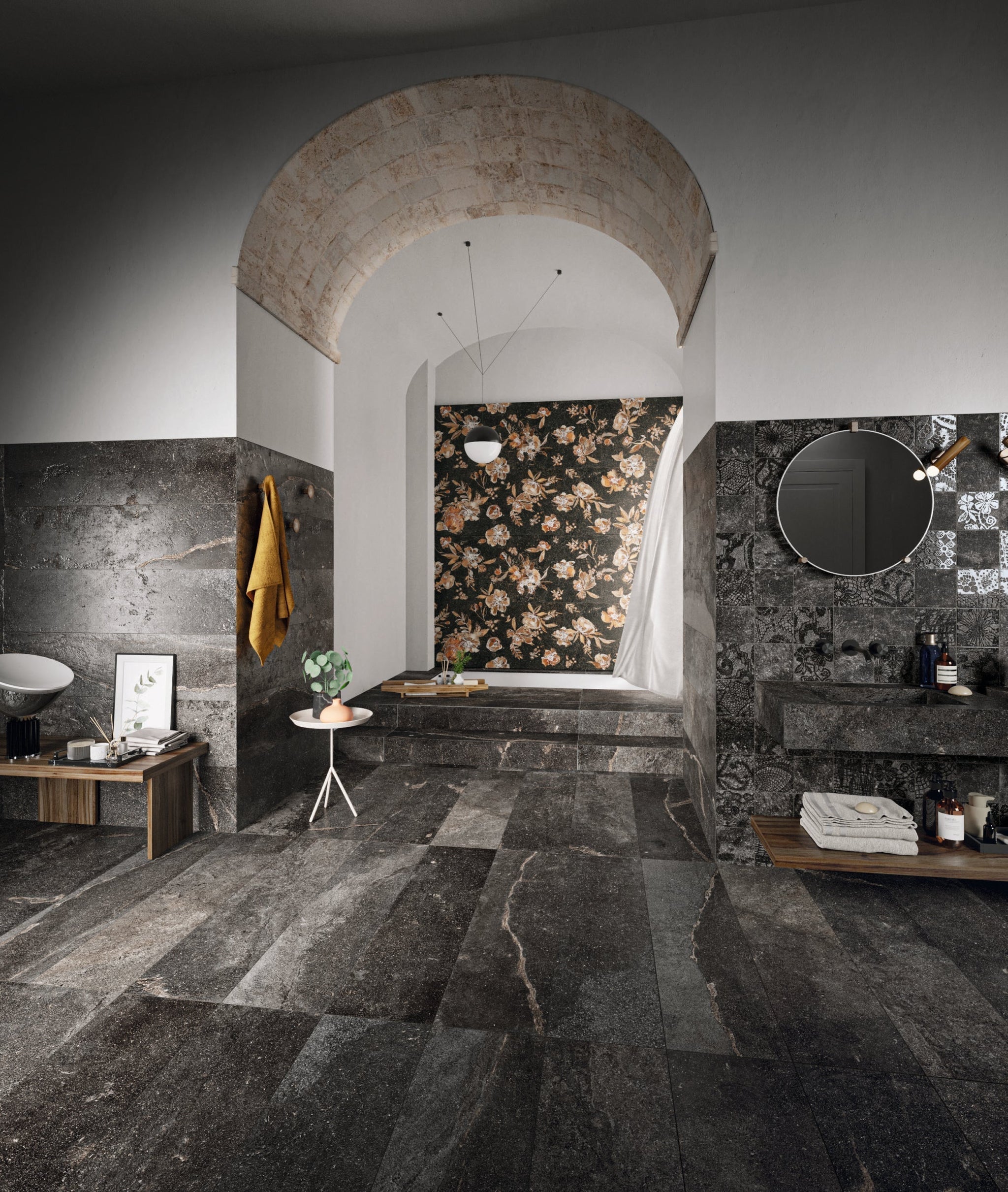When choosing the right flooring option for your home or business, there are numerous factors to consider. Durability, aesthetics, and cost are just a few of the key considerations. Ceramic and porcelain flooring have long been popular for their versatility and low maintenance. However, many people need clarification about the differences between the two options and which is best suited to their needs. In this comprehensive guide, we will examine ceramic and porcelain tile flooring in detail, exploring the advantages of each
Differences Between Porcelain Tile and Ceramic Tile
Understanding Ceramic Flooring
When it comes to ceramic flooring, a few key characteristics make it a popular choice for flooring solutions. Firstly, ceramic tiles are made from natural clay and other inorganic materials, fired at high temperatures to create a durable and solid finish. This manufacturing process gives ceramic tiles strength and resistance to heavy use.
Regarding aesthetics, ceramic tiles come in various colors, patterns, and sizes, making them a versatile option for any design style. Whether you prefer a sleek and minimalist look or a bold and vibrant statement, ceramic tiles can be customized to suit your taste.
One of the main advantages of ceramic flooring is its affordability. Ceramic tiles are typically more budget-friendly than porcelain tiles, making them an attractive option for those looking to upgrade their flooring without breaking the bank.
However, it is important to note that ceramic tiles are less dense than porcelain tiles. This means they may be more prone to chips and cracks if subjected to heavy impact. Additionally, ceramic tiles are more delicate and less porous, meaning they are less waterproof than porcelain tiles, making them less suitable for areas with high moisture, such as bathrooms or basements.
Understanding Porcelain Flooring
Porcelain tiles also offer a range of characteristics that make them a popular choice among homeowners and businesses. Porcelain tiles are made from a blend of fine clays and other natural materials, fired at higher temperatures than ceramic tiles. This firing process results in a denser and harder tile, making porcelain flooring highly resistant to scratches, stains, and moisture.
One of the standout features of porcelain flooring is its exceptional durability. Due to its density, porcelain tiles are less likely to chip or crack, even in high-foot traffic areas or when subjected to heavy impact. This makes porcelain flooring ideal for busy households or commercial spaces requiring long-lasting and low-maintenance flooring.
Additionally, porcelain tiles come in various styles, colors, and textures, allowing you to achieve any desired look. From modern and contemporary to rustic and traditional, a porcelain tile option suits every design aesthetic.
Regarding cost, porcelain tiles tend to be more expensive than ceramic tiles. However, the long-term benefits of porcelain flooring, especially its durability and wear resistance, can outweigh the initial investment.
Comparing The Durability of Ceramic and Porcelain Tile
When choosing flooring options, durability and resistance to wear are two important factors to consider. Both types of tiles are well-renowned for their hardiness, but certain aspects can make one more suitable for a particular project than the other.
Ceramic tiles are known for their durability and ability to withstand regular wear and tear. However, compared to porcelain tiles, they are more susceptible to chipping and cracking, especially in high-traffic areas. This makes ceramic tiles less ideal for busy households or commercial spaces that experience heavy foot traffic.
On the other hand, porcelain tiles are renowned for their exceptional durability. Thanks to their dense composition and firing process, they are highly resistant to scratches, stains, and moisture, ensuring that your flooring remains intact even in the busiest environments
.
Both ceramic and porcelain tiles offer excellent performance in terms of resistance to wear. However, porcelain tiles have a slight edge due to their higher density and hardness, making them an excellent choice for areas that experience heavy use, such as kitchens, hallways, and entryways.
Examining the Aesthetic Appeal of Ceramic and Porcelain Tile
Aesthetic appeal and design options play a significant role when choosing flooring. The range of design options available for each will help determine which flooring material will suit your project best.
Ceramic tiles offer various colors, patterns, and textures, making them a versatile choice for any design. From sleek and modern to rustic and traditional, ceramic tiles can be customized to fit your desired aesthetic. Advancing technology even allows manufacturers to mimic the look of natural stone or hardwood, providing endless design possibilities.
Porcelain tiles also offer an extensive range of design options. In various sizes, colors, and finishes, porcelain tiles can create a sleek and contemporary look or emulate the warmth and character of natural materials. Their versatility makes them suitable for residential and commercial spaces, offering an array of design choices for any style preference.
When comparing the aesthetic appeal and design options of ceramic and porcelain tiles, it ultimately comes down to personal preference. Consider the overall style of your space, the desired ambiance, and the functionality of the tiles to make an informed decision.
Maintenance and Cleaning Needs of Ceramic and Porcelain Tile
When it comes to maintaining and cleaning ceramic and porcelain tiles, both perform admirably; however, comparing the maintenance virtues of each can prove to be the deciding factor between the two.
Ceramic tiles are relatively easy to clean and maintain. Regular sweeping or vacuuming followed by mopping with a mild cleaning agent is usually sufficient to keep them looking clean and fresh. However, it's worth noting that the grout lines between ceramic tiles can accumulate dirt and stains over time, requiring periodic deep cleaning or resealing.
Porcelain tiles are even easier to maintain; thanks to their low porosity, they are highly resistant to stains and dirt. Regular sweeping or vacuuming is usually enough to keep them clean. Additionally, grout lines with porcelain tiles are less prone to staining, reducing the need for frequent resealing.
For long-term maintenance, ceramic and porcelain tiles can benefit from occasional professional cleaning and sealing to ensure longevity and aesthetic appeal. Overall, when it comes to maintenance and cleaning, both types of tiles are relatively low-maintenance options, with porcelain tiles being slightly more resistant to staining and dirt accumulation.

Photo courtesy of wikihow

Usages Porcelain vs. Ceramic Tile
Ceramic tiles, since they're more delicate, are great for areas that don't have excessive traffic. And with the vast amount of colors and design options available, they're perfect for accent walls and kitchen back splashes.
Porcelain tiles are typically more durable so they're great to use on exterior walls, countertops or even as flooring (both indoors and outdoors!) We often see porcelain tile as living room and bathroom flooring because of their capability to withstand foot traffic.


Making the Decision: Ceramic Vs. Porcelain
In the end, selecting the right flooring option depends on finding the perfect balance between your priorities and the characteristics offered by ceramic and porcelain tiles.
Factors such as budget, style, maintenance, and foot traffic should also influence your decision. To ensure you make an informed choice, consult with professionals, request product samples, and evaluate each option's pros and cons based on your circumstances.
Avalon’s design specialists can help you decide which option best suits your home or business flooring project. Contact us or schedule a showroom visit online to begin your renovation project today.




















